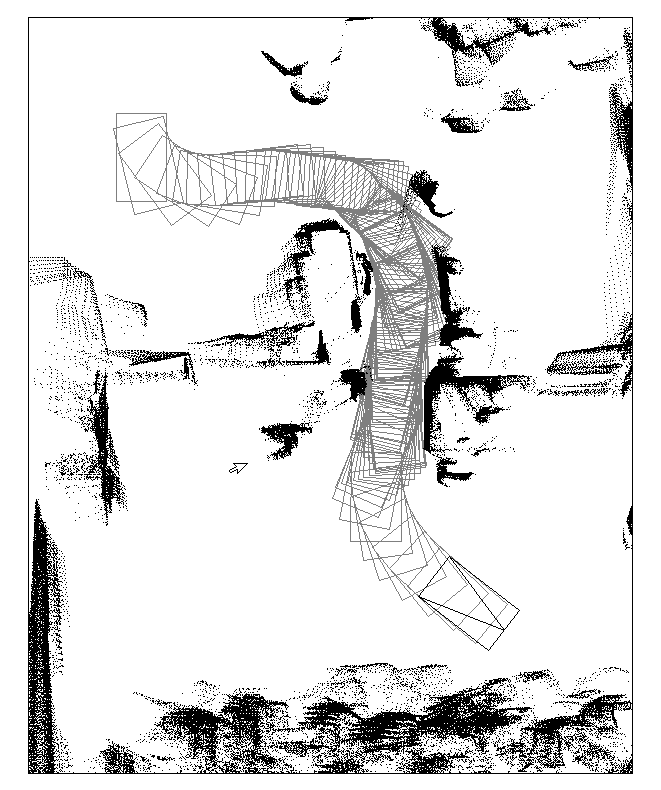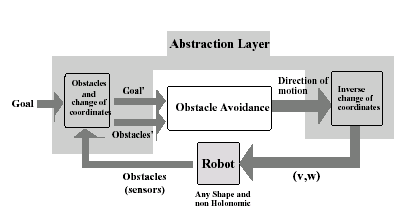




|
|
Obstacle Avoidance
Obstacle Avoidance is a robotic discipline with the objective of moving
vehicles on the basis of the sensorial information. The use of these
methods front to classic methods (path planning) is a natural alternative
when the scenario is dynamic with an unpredictable behaviour. In these
cases, the surroundings do not remain invariable, and thus the sensory
information is used to detect the changes consequently adapting moving.
The research conducted faces two major problems in this discipline. The
first is two move vehicles in troublesome scenarios, where current
technology has proven limited aplicability. The second one is to
understand the role of the vehicle characteristics (shape, kinematics and
dynamics) within the obstacle avoidance paradigm.
 | Motion in Troublesome scenarios |
Nearness Diagram
Navigation: This method addresses obstacle avoidance for vehicles that
move in very dense, cluttered and complex scenarios. The method uses a
``divide and conquer'' strategy based on situations to simplify the
difficulty of the navigation. Many techniques could be used to
implement this design (since it is described at symbolic level)
leading to new obstacle avoidance methods that must be able to
navigate in arduous environments (as the difficulty of the navigation
is simplified). The geometric implementation of the method is called
Nearness Diagram Navigation. The advantage is to successfully move
robots in troublesome scenarios, where other methods present a high
degree of difficulty to navigate.
The next Figure depicts the divide
and conquer strategy based on situations:
.gif)
And some results with the wheelchair vehicle:
.gif) |
 |
Most Relevant Related Publications:
-
J. Minguez,
L. Montano. Nearness Diagram Navigation (ND): Collision Avoidance in
Troublesome Scenarios.
IEEE Transactions on
Robotics and Automation,
pp 154, 2004. (pdf)
-
J. Minguez, J. Osuna, L. Montano.
A Divide and Conquer Strategy based
on Situations to Achieve Reactive Collision Avoidance in Troublesome
Scenarios.
In Proceedings of the IEEE International Conference on Robotics and
Automation (ICRA),
2004. New Orleans, USA. (pdf)
 | Shape, Kinematics and Dynamics in Obstacle
Avoidance |
--- Shape and Kinematics
Most obstacle avoidance techniques do not take into
account vehicle shape and kinematic constraints. They assume a
punctual and omnidirectional vehicle and are doomed to rely on
approximations. Our contribution is a framework to consider shape and
kinematics together in a exact manner, in the obstacle avoidance
process, by abstracting these constraints from the avoidance method
usage. Our approach can be applied to many non holonomic vehicles with
arbitrary shape.
For these vehicles, the configuration space is 3
dimensional, while the control space is 2-dimensional. The main idea
is to construct (centred on the robot at any time) the two-dimensional
manifold of the configuration space that is defined by elementary
circular paths. This manifold contains all the configurations that can
be attained at each step of the obstacle avoidance and is thus general
for all methods. Another important contribution of the paper is the
exact calculus of the obstacle representation in this manifold for any
robot shape (i.e. the configuration regions in collision). Finally, we
propose a change of coordinates of this manifold in such a way that
the elementary paths become straight lines. Therefore, the
3-dimensional obstacle avoidance problem with kinematic constraints is
transformed into a simple obstacle avoidance problem for a point
moving in a 2-dimensional space without any kinematic restriction (the
usual approximation in obstacle avoidance). Thus, existing avoidance
techniques become applicable.

Most relevant publications:
- J. Minguez,
L. Montano. Abstracting vehicle Shape and Kinematics constraints from
Obstacle Avoidance Methods.
Autonomous Robots, 2005. (pdf draft)
-
J. Minguez, L. Montano, J.
Santos-Victor. The Ego-Kinematic Space (EKS):
Shape and Kinematics of the Vehicle.
In Proceedings of the IEEE International Conference on Robotics and
Automation (ICRA),
2002. Washington, USA. (pdf)
--- Dynamics
This research addresses
the incorporation of the vehicle dynamics into the obstacle
paradigm. We present a framework specially suited to systems where the
dynamics cannot be neglected: mobile robots with slow dynamic
capabilities, or systems working at relatively high speeds.
Rather than embedding the motion constraints when
designing a navigation method, we propose to introduce the robot
dynamic constraints directly into the spatial representation. In this
space - the Ego-Dynamic Space - the dynamic capabilities of the robot
are implicitly represented. With minor modifications, standard
reactive navigation methods can be used in this space implicitly
taking into account the robot dynamic constraints.
To validate this framework, we show
experiments with a real platform using two reactive navigation methods
(the Nearness Diagram Navigation and the Potential Field method). By
using the proposed framework, the vehicle dynamics are directly
addressed, whereas both methods do not take the robot dynamic
constraints into account.
Most
relevant publications
-
J. Minguez, L. Montano, O. Khatib.
The Ego-Dynamic Space (EDS): Dynamics
of the Vehicle.
In Proceedings of the Conference on Intelligent Robots and Systems (IROS),
2002. Lausanne, Switzerland (pdf)
--- Shape, Kinematics and
Dynamics
This research merges the previous
works in order to deal with the three vehicle characteristics jointly,
Most relevant publications:
-
J. Minguez, L. Montano. The
Ego-KinoDynamic Space (EKDS): Shape,
Kinematics and Dynamics of the Vehicle.
In Proceedings of the Conference on Intelligent Robots and Systems (IROS),
2003, Las Vegas, USA (pdf)
Back to Research Page
Back to Main Page
|
| |
|

